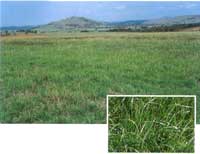Alexandra, Victoria, Australia
May 1999
Extreme climate breeding is a new concept for forage grasses. Most forage grass breeding
has been undertaken in climates that are relatively mild. Australian company Valley Seeds
Pty Ltd. has been using the concept of extreme climate breeding for the past 25 years.
Mainly concentrating its efforts on Ryegrass breeders at Valley Seeds have recently
released a new perennial ryegrass that has outstanding drought and heat tolerance.
 The variety was appropriately named Camel and according to the
managing director of Valley Seeds Mr. Donald Coles, is likely to be the most drought
tolerant perennial ryegrass in the world. 'The parent plants of Camel were selected from a
region in the south east of Australia that has an average annual winter dominant rainfall
of 450mm (18"). These plants had survived a record drought in 1982 and several years
of intensive grazing pressure by sheep.' said Mr. Coles. The variety was appropriately named Camel and according to the
managing director of Valley Seeds Mr. Donald Coles, is likely to be the most drought
tolerant perennial ryegrass in the world. 'The parent plants of Camel were selected from a
region in the south east of Australia that has an average annual winter dominant rainfall
of 450mm (18"). These plants had survived a record drought in 1982 and several years
of intensive grazing pressure by sheep.' said Mr. Coles.
'As Australia's first private grass breeder we were in a unique position to take advantage
of the natural selection that has taken place in ryegrass since European settlement.
Australia's extreme climate has created fundamental changes to Ryegrass's that were first
introduced from Europe. The hard part has been to concentrate drought and heat tolerance
genes in what was an extremely variable plant population.
Australian farmers needed a grass that is more palatable than cocksfoot, not toxic like
phalaris but fast to establish. Ryegrass was the obvious choice because it not only had
the potential to solve these problems but also produces good quality forage in winter. The
reality was, however that perennial ryegrass rarely persists below an annual rainfall of
700mm (27"). Camel perennial
ryegrass represents a breakthrough in persistence of perennial ryegrass.
Camel was not bred for high rainfall regions with occasional drought or regions that
regularly receive summer rainfall. It was bred specifically for mediterranean climates,
which are those with mild wet winters and hot dry summers.
Camel also has the added value of very high winter forage yields but this was not achieved
at the expense of spring forage yields, which are also excellent. Persistence in summer
dry climates sometimes comes from plants with a pre-disposition to summer dormancy. This
is not the case with Camel.' said Mr. Coles.
Camel is currently being tested in many regions of the world including USA, South Africa
and Spain. Camel is registered in Australia under plant breeder's rights. Valley Seeds is
continuing its efforts to breed even more drought tolerant varieties and hopes to extend
the area that perennial ryegrass will persist in areas with annual rainfall well below
that currently possible with Camel.
For more information and trial data on Camel Perennial Ryegrass and other varieties in the
breeding programme contact Donald Coles from Valley Seeds at dcoles@valleyseeds.com. Company news release
N1810 |